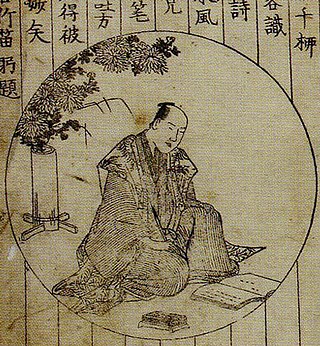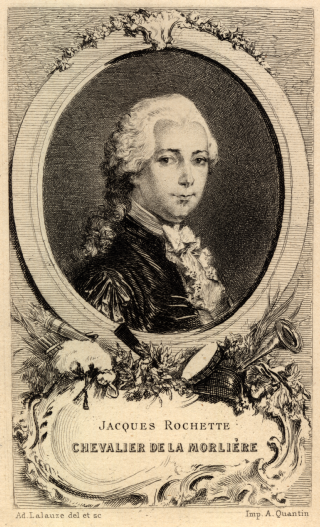Related Research Articles
This article contains information about the literary events and publications of 1735.
This article contains information about the literary events and publications of 1737.
This article contains information about the literary events and publications of 1741.
This article contains information about the literary events and publications of 1748.
This article contains information about the literary events and publications of 1749.
This article contains information about the literary events and publications of 1758.
This article is a summary of literary events and publications during 1764.

Namiki Sōsuke, also known as Namiki Senryū, was a prominent Japanese playwright who wrote for both kabuki and bunraku. He produced around 47 bunraku plays, nearly 40 of them composed for jōruri, a particular form of musical narrative, and 10 kabuki plays. He is considered the second greatest Japanese playwright after Chikamatsu Monzaemon.
Nationality words link to articles with information on the nation's poetry or literature.
Nationality words link to articles with information on the nation's poetry or literature.
Nationality words link to articles with information on the nation's poetry or literature.
Nationality words link to articles with information on the nation's poetry or literature.
Now the Assembly [the Kit-Kat Club] to adjourn prepar'd,
When Bibliopolo from behind appear'd
As well describ'd by th' old Satyrick Bard,
With leering Looks, Bull-fac'd, and Freckled fair,
With two left Legs; and Judas-colour'd [red] Hair,
With Frowzy Pores, that taint the ambient Air.
Sweating and Puffing for a-while he stood.
And then broke forth in this insulting Mood:Without my Stamp in vain your Poets write.
Those only purchase everliving Fame,That in my Miscellany plant their Name.
Nationality words link to articles with information on the nation's poetry or literature.

Sugawara Denju Tenarai Kagami is an ancient Japanese play that has been performed in bunraku and kabuki, and was jointly written by Takeda Izumo I, Takeda Izumo II, Namiki Sōsuke and Miyoshi Shōraku. Along with Yoshitsune Senbon Zakura and Kanadehon Chūshingura, it is one of the three most famous and popular plays in the kabuki repertoire. Sugawara was first performed as a puppet play in August 1746 at the Takemoto-za in Osaka, debuting on the kabuki stage the following month in Kyoto. The Edo debut was held at the Ichimura-za the following March.
Nationality words link to articles with information on the nation's poetry or literature.
Nationality words link to articles with information on the nation's poetry or literature.
Nationality words link to articles with information on the nation's poetry or literature.

Actor Ichikawa Ebijūrō as Samurai is an ukiyo-e Japanese woodblock print by Osaka-based late Edo period print designer Shunshosai Hokuchō. The print depicts a scene from a kabuki play featuring Osaka actor Ichikawa Ebijūrō (市川蝦十郎) in the role of a samurai. One impression of the print belongs to the permanent collection of the Prince Takamado Gallery of Japanese Art in the Royal Ontario Museum, Canada.
Events from the year 1746 in France

Charles-Jacques-Louis-Auguste Rochette de La Morlière, called "Le Chevalier", was an 18th-century French playwright.
References
- ↑ In Britain, Voltaire's speech is quoted in The Gentleman's Magazine in July and the full text is translated into English in Dodsley's Museum for December 20. Clark, Alexander Frederick Bruce (1971). Boileau and the French Classical Critics in England (1660–1830). Franklin, Burt. pp. 40, 43. ISBN 978-0-8337-4046-5 . Retrieved 2010-02-13.
- ↑ John Hawkins (1787). The Life of Samuel Johnson, LL.D. J. Buckland. p. 345.
- ↑ The ballad, related orally for a century, is first printed in Josiah Gilbert Holland's History of Western Massachusetts in 1855. Burt, Daniel S. (2004). The Chronology of American Literature: America's literary achievements from the colonial era to modern times. Houghton Mifflin Harcourt. ISBN 978-0-618-16821-7.
- ↑ Kavanagh, Thomas M. (2001). "Coupling the Novel: Reading Bodies in La Morlière's Angola". Eighteenth-Century Fiction. 13 (2–3): 389–414. doi:10.1353/ecf.2001.0018. S2CID 162335040.
- ↑ Shōriya, Aragorō. "Sugawara Denju Tenarai Kagami." Kabuki21.com. Accessed 4 December 2008.
- ↑ Schrödter, Willy (2003). Abenteuer mit Gedanken: Mächte und Gewalten in uns (in German). Reichl Verlag. p. 18. ISBN 978-3-87667-249-6.
- ↑ Halbertsma, R. B. (2003). Scholars, Travellers, and Trade. Routledge. pp. 11–14.